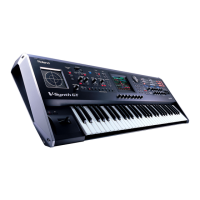Vocal Desi
ner” is a further evolution of the “vocoder.” This function was featured on the VP-550,
an
is a
so provi
e
on t
e V-S
nt
GT.
ocal Desi
ner uses cuttin
-ed
e model-
ing tec
no
ogy to attain a revo
utionary
eap in s
nt
esis precision, succee
ing in
ro
ucing “
uman voice” t
at is incom
arabl
more natural and realistic than
onventional vocoders. Vocal Designer uses
he audio
rom the mic to express elements
the sound other than pitch. The pitch is
ontrolled from the ke
board.
Simp
p
a
ing t
e
e
oar
or simp
voca
izing into t
e mic wi
not ma
e Voca
Designer pro
duce sound. The important thing about learning to take advantage o
Vocal Designer is the timing
at which you play the keyboard and vocalize into the mic. For phrases involving rapid passages,
it’s best to hold down the notes on the keyboard, and mark the rhythm using your voice
Un
i
e conventiona
synt
esizers, you’
use t
e mic to contro
t
e vo
ume. In ot
er wor
s, you’re
sing
our voice to
escri
e t
e vo
ume curve. Tr
using
our voice to a
expression to an extent
ou mig
t consi
er excessive
P
a
i
e
ou’re singing”—that’s the most important technique
or taking advantage o
Vocal Designer.
T
e voco
er was invente
t
e p
sicist H. Du
e
n 1939 as a method o
compressing vocal signals.
Taking advantage o
this technology, the “vocoder
was born as an instrument that let you per
orm melo-
ies or harmonies usin
a human voice. O
course,
ou’re not
imite
to using a
uman voice as t
e au
io
source—an
au
io source can
e use
. Sti
, since t
e voco
er was
eve
ope
wit
t
e
uman
ocal apparatus as its starting point, we’ll explain how the human voice works.
The human voice starts
rom the “vocal cords.” Exce
t
or di
erences in
the
orce and the
itch o
the voice, and di
erences between individuals,
the vibrational wave
orm produced by the vocal cords does not change
signi cantl
even when di erent sounds (such as “aah” or “ooh”) are being
roduced. These sounds become intelligible as spoken words because of
arious resonances produced b
the vocal tract (i.e., changes in the shape
and structure o
the throat and movements o
the mouth) and time-varying
sounds known as “sibilants
” “
ricatives
” and “nasals.” The e
ect o
the wave-
orm produced by the vocal cords is relatively small
A voco
er ana
zes t
ese time-variant c
anges in t
e soun
, e
ectrica
s
n-
thesizes the changes in the shape of the throat and mouth (formant move
ents), and produces sound b
using these formants to modulate a signal from a musical instru
ent (the carrier) instead o
the signal
rom the vocal cords. “Voices” produced b
a vocoder in this
way are typically closer to a robot in a science
ction movie than to any actual human voice.
What is Vocal Designer?
01
Vocal cords (carrier)
Resonances (formants)
resulting from the vocal
tract (shape and structure
of the throat) and
movements of the mouth

